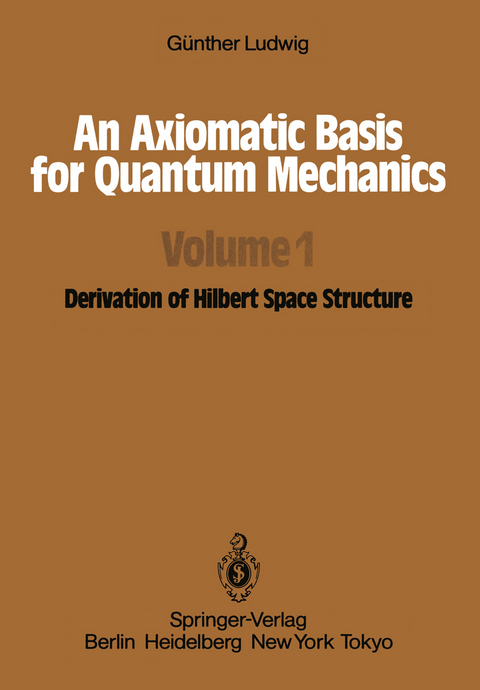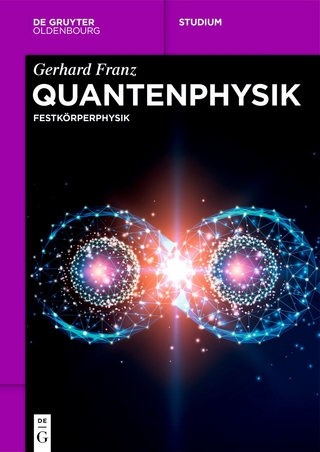
An Axiomatic Basis for Quantum Mechanics
Springer Berlin (Verlag)
978-3-642-70031-6 (ISBN)
I The Problem of Formulating an Axiomatics for Quantum Mechanics.-
1 Is There an Axiomatic Basis for Quantum Mechanics?.-
2 Concepts Unsuitable in a Basis for Quantum Mechanics.-
3 Experimental Situations Describable Solely by Pretheories.-
4 Mathematical Problems.-
5 Progress to More Comprehensive Theories.- II Pretheories for Quantum Mechanics.-
1 State Space and Trajectory Space.-
2 Preparation and Registration Procedures.-
3 Trajectory Preparation and Registration Procedures.-
4 Transformations of Preparation and Registration Procedures.-
5 The Macrosystems as Physical Objects.- III Base Sets and Fundamental Structure Terms for a Theory of Microsystems.-
1 Composite Macrosystems.-
2 Preparation and Registration Procedures for Composite Macrosystems.-
3 Directed Interactions.-
4 Action Carriers.-
5 Ensembles and Effects.-
6 Objectivating Method of Describing Experiments.-
7 Transport of Systems Relative to Each Other.- IV Embedding of Ensembles and Effect Sets in Topological Vector Spaces.-
1 Embedding of K, L in a Dual Pair of Vector Spaces.-
2 Uniform Structures of the Physical Imprecision on K and L.-
3 Embedding of K and L in Topologically Complete Vector Spaces.-
4 ?, ?', D, D' Considered as Ordered Vector Spaces.-
5 The Faces of K and L.-
6 Some Convergence Theorems.- V Observables and Preparators.-
1 Coexistent Effects and Observables.-
4 Coexistent and Complementary Observables.-
5 Realization of Observables.-
6 Coexistent De-mixing of Ensembles.-
7 Complementary De-mixings of Ensembles.-
8 Realizations of De-mixings.-
9 Preparators and Faces of K.-
10 Physical Objects as Action Carriers.-
11 Operations and Transpreparators.- VI Main Laws of Preparation andRegistration.-
1 Main Laws for the Increase in Sensitivity of Registrations.-
2 Relations Between Preparation and Registration Procedures.-
3 The Lattice G.-
4 Commensurable Decision Effects.-
5 The Orthomodularity of G.-
6 The Main Law for Not Coexistent Registrations.-
7 The Main Law of Quantization.- VII Decision Observables and the Center.-
1 The Commutator of a Set of Decision Effects.-
2 Decision Observables.-
3 Structures in That Class of Observables Whose Range also Contains Elements of G.-
4 Commensurable Decision Observables.-
5 Decomposition of ? and ?' Relative to the Center Z.-
6 System Types and Super Selection Rules.- VIII Representation of ?, ?' by Banach Spaces of Operators in a Hilbert Space.-
1 The Finite Elements of G.-
2 The General Representation Theorem for Irreducible G.-
3 Some Topological Properties of G.-
4 The Representation Theorem for K, L.-
5 Some Theorems for Finite-dimensional and Irreducible ?.- A II Banach Lattices.- A III The Axiom AVid and the Minimal Decomposition Property.- A IV The Bishop-Phelps Theorem and the Ellis Theorem.- List of Frequently Used Symbols.- List of Axioms.
| Erscheint lt. Verlag | 17.11.2011 |
|---|---|
| Übersetzer | L.F. Boron |
| Zusatzinfo | X, 246 p. |
| Verlagsort | Berlin |
| Sprache | englisch |
| Maße | 170 x 244 mm |
| Gewicht | 454 g |
| Themenwelt | Naturwissenschaften ► Physik / Astronomie ► Festkörperphysik |
| Naturwissenschaften ► Physik / Astronomie ► Quantenphysik | |
| Naturwissenschaften ► Physik / Astronomie ► Theoretische Physik | |
| Technik ► Maschinenbau | |
| Schlagworte | atoms • Behavior • electron • Electrons • elementary particle • Mechanics • particles • quantum mechanics • space • Space Structure • Structure |
| ISBN-10 | 3-642-70031-4 / 3642700314 |
| ISBN-13 | 978-3-642-70031-6 / 9783642700316 |
| Zustand | Neuware |
| Haben Sie eine Frage zum Produkt? |
aus dem Bereich


